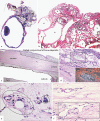Massive Silicone-Induced Orbital Granuloma
- PMID: 32258023
- PMCID: PMC7109432
- DOI: 10.1159/000501295
Massive Silicone-Induced Orbital Granuloma
Abstract
We report a large subconjunctival-orbital granuloma in a 51-year-old male presenting with a blind painful right eye and marked chemosis 15 months after undergoing vitrectomy and silicone oil retinal tamponade for retinal detachment with no reported intraoperative complications. Gross and histopathologic examination of the enucleated eye and episcleral tumor revealed a bosselated mass measuring 17 × 10 × 5 mm containing prominent vacuoles with surrounding epithelioid histiocytes and foreign body multinucleated giant cells. Such a large silicone-induced orbital granuloma following uncomplicated retinal surgery in a grossly intact eye has not been previously reported to the authors' knowledge. High intraocular pressure and emulsification of oil may facilitate silicone extravasation through scleral wounds after retinal surgery.
Keywords: Case report; Scanning electron microscope-energy dispersive spectroscopy; Silicone-induced orbital granuloma.
Copyright © 2019 by S. Karger AG, Basel.
Conflict of interest statement
The authors have no conflicts of interest to declare.
Figures



References
-
- Abel AD, Carlson JA, Bakri S, Meyer DR. Sclerosing lipogranuloma of the orbit after periocular steroid injection. Ophthalmology. 2003 Sep;110((9)):1841–5. - PubMed
-
- Couch SM, Harocopos GJ, Holds JB. Orbital silicone oil granuloma discovered during enucleation. Arch Ophthalmol. 2012 Aug;130((8)):1083–5. - PubMed
-
- Travis WD, Balogh K, Abraham JL. Silicone granulomas. A review of the literature and report of 3 cases. Hum Pathol. 1985;16:19–27. - PubMed

